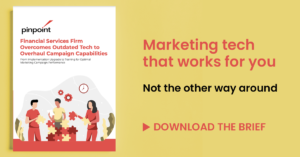Summary
- The decision of whether to buy or build marketing technology involves trade-offs in cost, complexity, and risk.
- Building a custom martech stack can result in technical debt and requires specialized skills, with potential challenges in deployment and future maintenance.
- Buying technology may not meet all requirements and could lead to out-of-date tools or additional fees for desired functionality.
- Prioritize the problems you want to solve and the opportunities you’re ready to seize to guide your decision-making process.
- Consider a hybrid approach where you creatively build around a core system to strike a balance between cost, features, and time to deployment, eventually transitioning to a more mature and automated platform.
- Seek advice from experienced individuals who have dealt with both buying and building to gain insights into the pros, cons, pain points, and rewards of each approach.
- Ultimately, the solution often lies somewhere in between buying and building, and the decision should inform your long-term martech strategy.
Marketing technology is constantly evolving. New tactics (and the tech that powers them) make big promises to boost customer relationships. So when you need crucial new capabilities— more personalization, stricter data privacy, real-time marketing — what’s the best approach? Buy, build… or a little of both?
People have been debating for decades about different versions of tech. At its essence, the question ultimately comes down to trade-offs: cost versus benefits, complexity versus velocity, risk versus reward.
Building can lead to accrued technical debt
The best-case scenario on a build is that it works. If you manage a miracle, deadlines and cost projections are met, and adoption is relatively smooth. As most people know, those things don’t tend to happen – so building a custom martech stack comes down to if the risk of overages, including the future cost of maintaining your build, will pay off. Not to mention, the skill set for creating your own solutions is highly specialized.
And regardless of how initial deployment goes, it’ll take manpower to keep a custom system running when it requires big changes after a platform or codebase upgrade. Tech debt is real, so consider what will be needed 2+ years out from a large custom coding effort.
Buying may not check all the boxes
There are plenty of top-tier technologies to choose from; brands with great marketing and seemingly ample support to get you up and running. But you might discover that it doesn’t work for what you need, or there are bolt-ons or upgrades that require extra fees and maintenance. The lack of flexibility means you may be left with out-of-date tools, and still spending to get the functionality you need.
The best starting point… what problems are a priority to solve?
Or, in other words, what opportunities are you ready to seize? Do engagement rates need a boost? Could revenue improve with predictive product suggestions?
In our experience, that helps give clarity to the questions of “How do we best do this? What tech is involved, and what steps?” A roadmap rooted in requirements and needs instead of tasks and deadlines will keep you true to your goals. It will also help you tie in the people and process that will support the tech.
Talk to people who have done both, like us! Ask them the pros and cons, the pain points, and the rewards from each approach. Ask them how long different things took, and what took longer than expected. Kick tires on what’s possible and what isn’t possible.
If you buy, consider… how much assembly is truly required. Not all point solutions are ready out-of-the-box. You’ll need to do a semi-to-heavy lift to get them where you want. You can read reviews to learn some of this, but it’s best to talk to old colleagues, friends, and people who work in this space all week.
And, when did you hear of an option to buy only what you need? Most of the time you pay for an entire bundle of tools, regardless of how many you actually need and end up using.
It’s worth mentioning here that “buying” could mean the technology itself, or it could also mean buying the services to upgrade your tech stack. The latter case often lends itself to a buy/build hybrid – something that we often pursue to help achieve the right balance between cost, features, and time to deployment.
If you build, consider… What will it cost to get it done, maintain it, and keep pace? Will the additional amenities pay for themselves through increased revenue? Will customer relationships suffer if we take the time to build?
Maybe the biggest question to answer when it comes to build is if you have the cross functional chops to get it done. Collaborating across departments is a challenge for most companies, and can be a huge barrier to building the right martech solution.
It’s easy to feel like you’re between a rock and a hard spot: there’s pressure to improve the martech stack but budgets and team resources are static. And, if you’ve never done a build before, there’s the risk that even if you have the budget, technical, strategy chops to outperform competition with a fresh build, the time lost will put you way behind. After 2-3 years – the typical deployment timeline – you may realize, “Oh, maybe we should have bought.”
You can have the best of both worlds
By thinking creatively, you can build scaffolding around a core system and get most of what you’re looking for in an ideal martech stack. It’s less about perfection and more about finding the right balance. This is what we’ve helped plenty of clients do, and the phased approach has helped many of them build a case for moving to a more mature, automated platform.
Final thoughts… and a martech analogy
In the end, the best advice we can give is that you don’t have to choose between getting it done now, and getting it done right. Just to talk to people who know have done both and any combination in between, not just once but dozens of times. More often than not, the solution is somewhere in between and regardless of which direction you go in, it’s an opportunity to inform your long-term martech strategy.
When in doubt, get in touch with us. We’ve helped companies make tough decisions between what to buy or build. We thrive on coming up with solutions no matter the deadlines and constraints – so chances are, if you think your situation is tough, we’ve seen it before.




